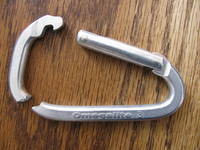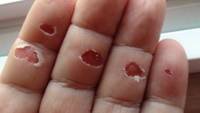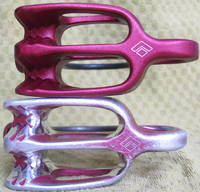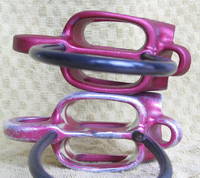Resources --- 1/19/2011 --- Lindseth
Vertical Rescue Curriculum
============================================ Vertical Rescue Syllabus (Updated Fall 2015) ============================================ Handout -- 50 Mistakes, (MS Word format) Climbing Magazine, issue 299, October, 2011, p.58 http://www.climbing.com/skill/50-ways-to-flail Handout -- Suspension Trauma Reading -- Top 5 Takeaways from Accidents in North American Climbing 2017, by Dougald MacDonald Resource -- The Sharp End Podcast Case Study -- Single Bolt Failure Josh's New Discussion Scenarios -- PDF Format ------- Class 1 ------- Intro (show & tell favorite gear) Case Study: Laurel Knob Throw out favorite gear Prussik demo (lower climber off end of rope) Ascending (Fasulo, p.36) 2 Prussiks from ground 2 Prussiks from hanging start 1 Prussik from autobloc rappel 1 Prussik from end of rope New knots (ATC + mule, munter + mule, double fisherman) ------- Class 2 ------- Demo: Burn through sling by lowering climber Case Study: Touching The Void ANAM 2005, p. 35 Belay Escapes (Fasulo, p.27) Munter/Mule Passing a Knot While Lowering (Fasulo, p.41) Passing a Knot While Rappelling (Fasulo, p.49) ------- Class 3 ------- Demo: Break nose-hooked carabiner with lead fall Case Study: Hauling through lip of crevasse on Kahiltna Glacier, no ANAM reference Kahiltna rescue where climbers had pretied prussiks incorrectly and also couldn't haul, ANAM 2000, p.33 Hauling (Fasulo, p.75) 3:1 5:1 2:1 assisted Belaying from above with autoblocking device Belaying two seconds (risk of device not locking if ropes come from different directions) Lowering one climber, lowering two climbers Demo required mechanical advantage for various frictions (free hanging, roof, 180 bend over carabiner) by how many rescuers it takes to haul one victim. ------- Class 4 ------- Demo: Break spectra sling in FF2 fall with weights Case Study: Randal Grandstaff rappel failure, June 2002 on Great Red Book in Red Rock, no ANAM report YOSAR letting unknotted rope slip through belay device, ANAM 2005, p.42 Proper Rappel Setup Tandem Rappel (Fasulo, p.51) Barrel Knot Autoblock Passing knot on tandem rappel Stuck Rappel Ropes EDK Clove Hitch ------- Class 5 ------- Demo: FF2 Belay Failure demo (2nd anchor bar in right-most crack). Demo w & w/o Jesus nut. Lead rope tail should shoot through belay device. Leather gloves for belayer. Backup belay needs lots of slack. Scenarios: Standard Follower Haul Rescue Standard Leader Rescue Rap Rope Stuck in Tree Prussiking Through Roof Student Refuses to Leave Belay Ledge After Disassembling Anchor Multipitch Tandem Rappel With Unconscious Victim Hair Stuck on Rappel Bonus Material: Mariner Hitch 1:1 body haulAlso, this leader rescue scenario. These conundrums. And these scenarios.



